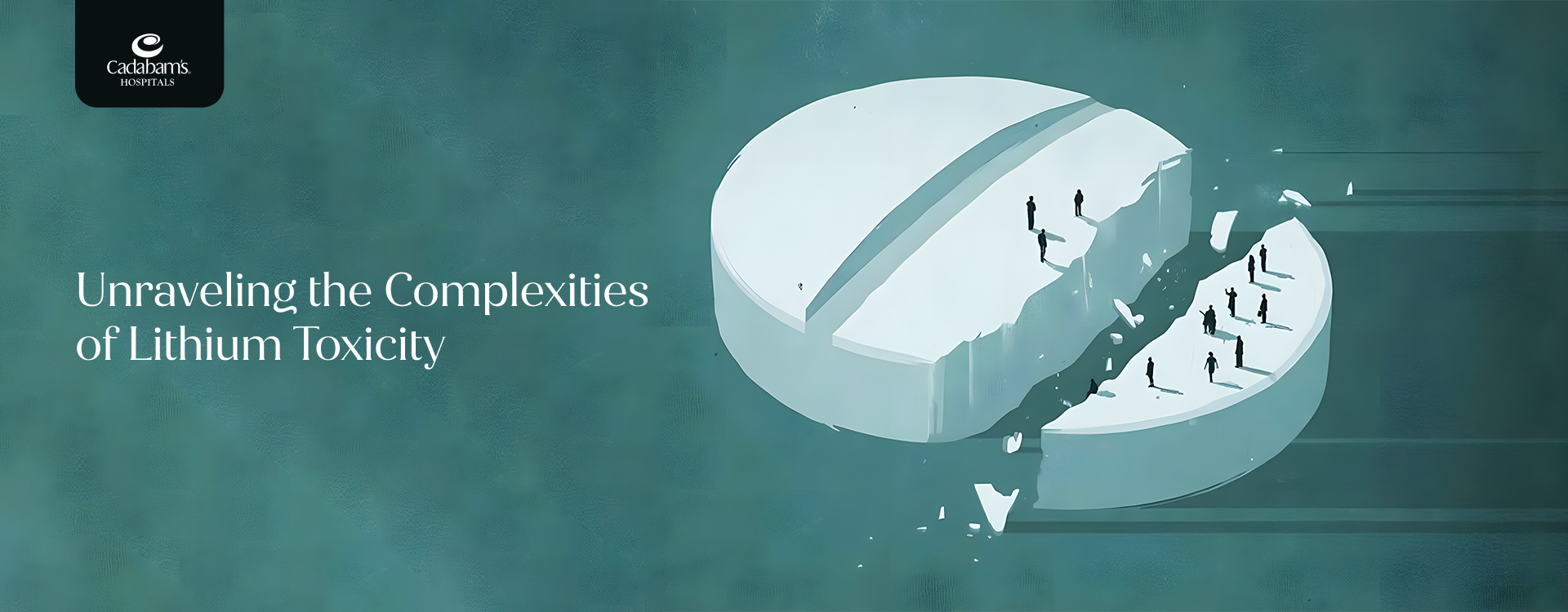Table of Content
In recent years, the term ‘lithium’ has gained traction in discussions surrounding mental health treatment. As a stalwart in the world of bipolar disorder and depression management, lithium has long been prescribed to help stabilize mood swings and alleviate symptoms.
However, there is a darker side to this seemingly miraculous mineral—its potential for toxicity. Often, patients on lithium therapy must maintain a delicate balance between therapeutic benefits and toxic risks.
A slight deviation from this equilibrium can have profound psychological consequences, such as tremors, confusion, or even seizures. In this case, individual variability in lithium metabolism plays a significant role. A patient’s age, renal function, and genetic makeup all influence how their body processes and eliminates lithium.
The fear of toxicity can lead to patients underdosing, which hinders the medication's effectiveness. At the same time, patients who do not fully comprehend the dangers may inadvertently overdose.
Understanding Lithium Toxicity
Lithium toxicity, a critical concern in mental health treatment, occurs when lithium levels in the bloodstream become dangerously high. This element, used to manage bipolar disorder and depression, offers therapeutic relief but becomes a threat when exceeded
When lithium toxicity strikes, it wreaks havoc within the body.
Excess lithium can impair the function of vital organs such as the kidneys, thyroid, and nervous system. At the cellular level, it disrupts the balance of sodium and potassium ions, leading to abnormal electrical signaling in nerve cells.
This imbalance often manifests as a spectrum of neurological symptoms, including tremors, confusion, and seizures, making it an urgent concern for healthcare professionals.
Causes of Lithium Toxicity
Lithium toxicity, a concerning issue in mental health treatment, stems from various factors. Non-adherence to prescribed doses can lead to a hazardous buildup of lithium. For instance, a study in the "Journal of Affective Disorders" found that patients with bipolar disorder who didn't consistently take their lithium experienced higher toxicity risks.
Lithium interactions with other medications can disrupt its delicate balance. Common drugs like diuretics, used for blood pressure control, can elevate lithium levels. Additionally, dehydration, often overlooked, affects lithium excretion efficiency. Real-world cases exemplify how strenuous physical activities or hot weather can hinder the body's ability to manage lithium effectively.
Accidental Overdose
Accidental overdose is a sobering contributor to lithium toxicity, often rooted in misjudgment or confusion. Patients may inadvertently double-dose or confuse their medications, putting themselves at risk. A study in "Psychiatry Research" found that patient misunderstanding of dosing instructions was a leading factor in accidental lithium overdoses.
Furthermore, the presence of children or vulnerable adults in the household increases the risk of accidental ingestion. Heated emotional states during a crisis can disrupt the careful management of medications, raising the risk of lithium toxicity.
Drug Interactions
Lithium's therapeutic window is notoriously narrow, with levels slightly above or below the recommended range causing harm. Yet, various commonly prescribed medications can disrupt this balance.
Take, for instance, nonsteroidal anti-inflammatory drugs (NSAIDs), such as ibuprofen. When combined with lithium, these seemingly innocuous pain relievers can elevate lithium levels, potentially pushing them into toxic territory.
A 2015 study in the Journal of Clinical Psychopharmacology found that concurrent use of diuretics like hydrochlorothiazide also increased the risk of lithium toxicity. These medications interfere with the body's electrolyte balance, thereby affecting lithium clearance.
Renal Dysfunction
The kidneys, our chemical regulators, usually help excrete lithium, but when they falter, trouble brews. Numerous studies have demonstrated the link between renal dysfunction and lithium toxicity.
One study involving over 10,000 patients taking lithium found that those with mild renal impairment were twice as likely to experience lithium toxicity compared to those with normal kidney function. The risk further increased with more severe renal impairment.
The mechanisms underlying lithium toxicity in renal dysfunction are complex but involve impaired lithium clearance and altered electrolyte balance. Lithium's primary route of elimination is through the kidneys, and reduced kidney function leads to a slower elimination rate, resulting in lithium accumulation.
Additionally, renal dysfunction can disrupt electrolyte balance, affecting the body's ability to excrete lithium and further contributing to toxicity.
Dehydration
Lithium is eliminated from the body primarily through the kidneys, and dehydration can significantly impact its clearance. Take, for instance, a 35-year-old individual diligently managing their bipolar disorder with lithium who experiences a severe episode of gastroenteritis.
Profuse vomiting and diarrhea lead to dehydration, impairing kidney function. Dehydration-induced lithium toxicity is a less-discussed perspective that underscores the need for hydration for those on lithium therapy.
Further, studies show that dehydrated individuals exhibit impaired cognitive functions, affecting their ability to monitor medication intake.
Common Uses of Lithium
- Lithium has the potential to alleviate symptoms of treatment-resistant depression. Studies have shown that lithium can provide significant mood elevation in individuals who have not responded to antidepressants. This effect is attributed to lithium’s ability to regulate neurotransmitter activity, particularly serotonin and dopamine.
- It has also demonstrated efficacy in the treatment of anxiety disorders, particularly those characterized by persistent worry or fear. Its ability to calm the nervous system and reduce intrusive thoughts has proven to be beneficial for individuals with generalized anxiety disorder, social anxiety disorder, and panic disorder.
- Research suggests that lithium may hold promise in the treatment of substance abuse, particularly for individuals struggling with cocaine addiction.
- Lithium has the potential to mitigate suicidality across various mental health conditions. It may lower suicide risk by stabilizing mood, reducing aggression, and diminishing hopelessness.
- Beyond its immediate psychological impact, lithium exhibits neuroprotective properties that may play a crucial role in slowing cognitive decline. Studies suggest a potential link between lithium use and a decreased risk of neurodegenerative conditions like Alzheimer's disease.
Bipolar Disorder
Lithium, a seemingly simple element, has played a pivotal role in the treatment of bipolar disorder, a complex mental illness characterized by extreme mood swings. Its efficacy lies in its ability to stabilize these fluctuations, effectively taming the highs of mania and moderating the lows of depression.
It influences cellular signaling pathways, potentially altering gene expression and neurogenesis. Clinical studies have consistently demonstrated that it is particularly beneficial for individuals with rapid cycling bipolar disorder, characterized by frequent and unpredictable mood shifts.
Lithium, a seemingly simple element, has played a pivotal role in the treatment of bipolar disorder, a complex mental illness characterized by extreme mood swings. Its efficacy lies in its ability to stabilize it.
Augmentation in Depression
In the realm of mental health, lithium has emerged as a valuable tool for augmenting the efficacy of antidepressants in treating treatment-resistant depression (TRD), a condition characterized by a lack of response to standard antidepressant therapies.
A meta-analysis of 10 randomized, controlled trials revealed that lithium augmentation was associated with a 41.2% response rate compared to 14.4% in the placebo group. This marked difference highlights the potential of lithium to enhance antidepressant treatment outcomes. Lithium's impact extends beyond symptom alleviation.
It has shown promise in reducing the risk of suicidal ideation and attempts, a critical concern for TRD(treatment-resistant depression) patients.
Schizoaffective Disorder
Lithium's efficacy in schizoaffective disorder lies in its impact on neurotransmitters, specifically modulating dopamine levels. This dual-action prowess extends to stabilizing mood and mitigating psychotic symptoms, offering a comprehensive approach.
Within the brain, lithium's influence on the limbic system and prefrontal cortex plays a pivotal role in regulating emotional responses and cognitive functions. By fine-tuning these neural pathways, lithium helps rein in the erratic mood shifts and delusions characteristic of schizoaffective disorder.
Off-Label Uses
Antipsychotic medications, primarily designed for mental health, reveal a multifaceted efficacy that transcends traditional boundaries. Cluster headaches, excruciating in intensity, find relief through the modulation of neurotransmitters, hinting at a broader neurological impact beyond psychosis.
In the realm of impulse control disorders, these medications emerge as potential allies, addressing the intricate balance required for self-regulation. Perhaps surprising to some, antipsychotics extend their reach into the domain of Graves' disease, a condition typically associated with hyperthyroidism.
The intricate interplay between neurotransmitters, particularly dopamine, seems to wield an influence on mental health and the delicate orchestration of physiological processes.
Types of Lithium Toxicity
Lithium toxicity manifests in acute and chronic forms. Acute symptoms include tremors, vomiting, and confusion. Chronic toxicity presents with kidney dysfunction and neurological issues. Regular monitoring is crucial for those on lithium therapy.
Acute Lithium toxicity
Acute lithium toxicity, a potentially life-threatening condition, arises when lithium levels in the blood become dangerously elevated. The primary psychiatric medication for bipolar disorder, lithium's narrow therapeutic range, demands vigilant monitoring.
Beyond the physical symptoms—such as nausea, tremors, and impaired consciousness. This psychological turmoil extends beyond the individual's internal landscape, impacting interpersonal dynamics. Irritability and aggression can surface, casting a shadow on relationships.
Chronic Lithium toxicity
Chronic lithium toxicity, a less overt but insidious concern, emerges when prolonged exposure to therapeutic doses results in gradually accumulating levels of the medication in the body. Unlike its acute counterpart, chronic toxicity may present with subtle, nuanced psychological symptoms that often mimic underlying psychiatric disorders.
Cognitive dulling, memory disturbances, and affective blunting become hallmark features, challenging patients and clinicians to identify the cause. Chronic lithium toxicity can further detrimentally affect physical health, disrupting thyroid function and potentially leading to hypothyroidism or goiter formation.
Neurotoxicity
The exact mechanism of lithium neurotoxicity is not fully understood, but it is thought to involve a number of factors, including:
- Disruption of neurotransmitter signaling: Lithium can interfere with the release and uptake of neurotransmitters, such as serotonin, dopamine, and glutamate. These neurotransmitters play a vital role in regulating mood, cognition, and other mental functions.
- Damage to mitochondria: Mitochondria are the energy powerhouses of cells. Lithium can damage mitochondria, leading to reduced energy production and cellular dysfunction.
- Oxidative stress: Oxidative stress is a process that occurs when the body produces too many free radicals and unstable molecules that can damage cells. Lithium can increase oxidative stress in the brain, contributing to neurotoxicity.
Neurotoxicity from lithium use can manifest in a variety of ways, including:
- Mild symptoms: Mild symptoms of lithium neurotoxicity may include headache, fatigue, tremor, and cognitive impairment.
- Moderate symptoms: Moderate symptoms of lithium neurotoxicity may include ataxia (incoordination), dysarthria (slurred speech), and dysdiadochokinesis (inability to perform rapid, alternating movements).
- Severe symptoms: Severe symptoms of lithium neurotoxicity may include seizures, coma, and death.
Acute-on-Chronic Lithium Toxicity
Acute-on-chronic lithium toxicity (ACTL) is a serious condition that occurs when someone who has been taking lithium for a long time suddenly experiences an increase in lithium levels in the blood. This can happen due to a number of factors, such as medication interaction, dehydration, or kidney problems.
ACTL can be particularly devastating for the brain, as it combines the neurotoxicity of acute lithium poisoning with the long-term effects of chronic lithium exposure. This can lead to a wide range of cognitive and neurological problems.
The psychological impact of ACTL can be equally devastating. People with ACTL may experience anxiety, depression, and mood swings. They may also have difficulty maintaining relationships and performing their daily activities.
The good news is that ACTL is usually reversible if it is caught early and treated promptly. However, the longer ACTL goes untreated, the more likely it is to cause permanent damage to the brain.
Symptoms of Lithium toxicity
Lithium toxicity symptoms include tremors, vomiting, confusion, diarrhea, and, in severe cases, seizures and impaired consciousness. Regular monitoring is crucial.
Mild Symptoms
- Hand Tremors: Mild tremors, especially in the hands, are an early sign of lithium toxicity, reflecting its impact on neuromuscular control.
- Increased Thirst and Urination: Lithium's influence on kidney function can lead to excessive thirst and urination, signaling potential toxicity.
- Mild confusion or Irritability: Subtle changes in cognitive function, like confusion or irritability, may emerge, highlighting the need for careful evaluation in lithium therapy.
Severe Symptoms
- Impaired Consciousness: Lithium toxicity may result in altered mental states, ranging from con
- Uncontrollable Tremors: Pronounced and persistent tremors, beyond the typical side effects, indicate a severe impact on the nervous system.
- Life-threatening Electrolyte Imbalances: Lithium toxicity can disrupt electrolyte balance, risking cardiac complications and potentially becoming life-threatening if not promptly addressed.
Diagnosing and Testing
Diagnosing lithium toxicity involves assessing symptoms, checking lithium levels in blood, and monitoring kidney function. Regular blood tests are crucial for individuals on lithium therapy to prevent complications.
Initial Assessment
- 1. Clinical Evaluation: Assess symptoms like tremors and confusion to gauge the severity of lithium toxicity and guide intervention.
- 2. Medical History Review: Scrutinize patient history for factors influencing lithium levels, ensuring a comprehensive understanding of potential risk factors.
- 3. Lithium Levels Testing: Measure blood lithium concentrations to determine if levels exceed the therapeutic range, a critical step in diagnosis.
- 4. Kidney Function Tests: Assess renal health, as lithium is predominantly excreted through the kidneys; impaired function increases the risk of toxicity.
- 5. Electrolyte Assessment: Monitor electrolyte balance, which is crucial for preventing complications associated with severe lithium toxicity, such as cardiac issues.
Diagnostic Tests
- Serum Lithium Levels: Measure blood lithium concentrations to confirm toxicity, guiding treatment adjustments.
- Renal Function Tests: Evaluate kidney function through blood tests to assess the impact of lithium on renal excretion.
- Complete Blood Count (CBC): Identify any blood abnormalities associated with severe toxicity, aiding in comprehensive assessment.
- Electrolyte Panel: Assess levels of sodium and other electrolytes to prevent and manage potential imbalances induced by lithium toxicity.
- Thyroid Function Tests: Lithium can impact thyroid function; regular testing ensures timely detection of any related abnormalities during treatment.
Treatment Options
Lithium toxicity treatment involves discontinuing lithium, supportive care for symptoms, and, in severe cases, interventions like intravenous fluids and medications to enhance lithium elimination.
Mild Toxicity Treatment
- Discontinuation of Lithium: Cease lithium intake to prevent further buildup in the system.
- Hydration: Encourage fluid intake to aid natural elimination and mitigate mild symptoms.
- Close Monitoring: Regularly assess symptoms and lithium levels to ensure resolution.
- Symptomatic Relief: Address specific symptoms like nausea with appropriate medications.
- Renal Function Monitoring: Keep a watch on kidney function, as lithium excretion may impact renal health.
Moderate to Severe Toxicity Treatment
- Immediate Hospitalization: Severe cases require hospitalization for intensive care and continuous monitoring.
- Gastric Lavage or Charcoal Administration: Reduce lithium absorption in the gastrointestinal tract.
- Enhanced Elimination Therapy: Use methods like hemodialysis to expedite lithium removal.
- Electrolyte Correction: Address imbalances through intravenous interventions to stabilize the patient.
- Cardiac Monitoring: Continuous assessment for potential cardiac complications due to severe toxicity.
Prevention and Safety Tips
- Regular Monitoring: Consistent blood tests to maintain therapeutic lithium levels.
- Hydration: Encourage adequate fluid intake to support kidney function.
- Educate Patients: Ensure awareness of symptoms and the importance of reporting them promptly.
- Avoid Dehydration: Caution against factors like excessive exercise or heat exposure leading to dehydration.
- Regular Renal Function Tests: Monitor kidney health to identify early signs of impairment.
- Dosage Adjustments: Regularly assess and adjust lithium doses based on individual response.
- Patient Communication: Foster an open dialogue with healthcare providers to address concerns promptly.
Medication and Food Interactions
- Consistent Sodium Intake: Maintain a stable sodium level to counter lithium absorption variability.
- Avoid Diuretics: Diuretic use can enhance lithium retention, increasing the risk of toxicity.
- NSAIDs Caution: Nonsteroidal anti-inflammatory drugs may elevate lithium levels; use cautiously and monitor closely.
- Calcium Channel Blockers Interaction: Potential interference with lithium metabolism; careful monitoring required.
- Regular Thyroid Function Tests: Lithium can impact thyroid function; routine monitoring helps detect and address abnormalities.
- Caffeine Moderation: Excessive caffeine can affect lithium excretion; moderation is advised.
- Close Monitoring for Side Effects: Regularly assess for potential interactions, ensuring timely intervention and adjustments.
The Importance of Awareness and Timely Intervention
Recognizing the nuances of lithium toxicity underscores the pivotal role of awareness and prompt intervention. Beyond routine monitoring, fostering a collective understanding among patients and healthcare providers about subtle symptoms is paramount. Timely identification of these signs can avert the escalation of toxicity, preventing severe consequences. Emphasizing the significance of open communication channels and proactive reporting creates a collaborative approach to mental health care. In this dynamic landscape, where the delicate equilibrium of therapeutic benefits and potential risks unfolds, cultivating a culture of vigilance ensures that the narrative of lithium treatment remains one of precision, responsiveness, and optimal patient well-being.
Lithium Toxicity: Looking Ahead
Today, pioneering advancements, such as novel chelation therapies and precision medicine approaches, have emerged as potent antidotes. Groundbreaking studies unravel the intricate mechanisms underlying lithium's adverse effects, steering us toward safer grounds. By delving into pharmacogenomics and targeted interventions, the scientific community paves the way for personalized treatments.
With progressive methodologies, state-of-the-art facilities, and expert care, we at Cadabams continue to get closer to a future where lithium toxicity is not just understood but effectively mitigated.
FAQs
1. How is lithium toxicity different from an overdose?
Lithium toxicity is an elevated concentration of lithium in the blood, often stemming from therapeutic use. In contrast, an overdose occurs when the ingested amount surpasses the therapeutic range, leading to acute toxicity. Distinguishing between the two is crucial for appropriate medical intervention and management.
2. What should I do if I suspect someone has lithium toxicity?
If lithium toxicity is suspected, seek immediate medical attention. Contact a healthcare professional or emergency services. Treatment may involve supportive care, hydration, and monitoring lithium levels. Do not attempt self-treatment, as the severity of toxicity can vary, and professional evaluation is essential for appropriate intervention.
3. Are there any long-term effects of lithium toxicity?
Yes, long-term effects of lithium toxicity may include kidney damage, manifesting as nephrogenic diabetes insipidus, or chronic kidney disease. Neurological complications, such as cognitive impairment or tremors, can also occur. Regular monitoring of lithium levels and kidney function is essential to mitigate potential long-term consequences.
How Cadabam's Help you for Addiction?
- 410+ Professional Consultants
- 1,00,00+ Happy Faces
- 120+ Currently Seeking Treatments










